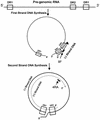Kinetic analysis of wild-type and YMDD mutant hepatitis B virus polymerases and effects of deoxyribonucleotide concentrations on polymerase activity
- PMID: 11897582
- PMCID: PMC127103
- DOI: 10.1128/AAC.46.4.1005-1013.2002
Kinetic analysis of wild-type and YMDD mutant hepatitis B virus polymerases and effects of deoxyribonucleotide concentrations on polymerase activity
Abstract
Mutations in the YMDD motif of the hepatitis B virus (HBV) DNA polymerase result in reduced susceptibility of HBV to inhibition by lamivudine, at a cost in replication fitness. The mechanisms underlying the effects of YMDD mutations on replication fitness were investigated using both a cell-based viral replication system and an in vitro enzyme assay to examine wild-type (wt) and YMDD-mutant polymerases. We calculated the affinities of wt and YMDD-mutant polymerases for each natural deoxyribonucleoside triphosphate (dNTP) and determined the intracellular concentrations of each dNTP in HepG2 cells under conditions that support HBV replication. In addition, inhibition constants for lamivudine triphosphate were determined for wt and YMDD-mutant polymerases. Relative to wt HBV polymerase, each of the YMDD-mutant polymerases showed increased apparent K(m) values for the natural dNTP substrates, indicating decreased affinities for these substrates, as well as increased K(i) values for lamivudine triphosphate, indicating decreased affinity for the drug. The effect of the differences in apparent K(m) values between YMDD-mutant polymerase and wt HBV polymerase could be masked by high levels of dNTP substrates (>20 microM). However, assays using dNTP concentrations equivalent to those measured in HepG2 cells under physiological conditions showed decreased enzymatic activity of YMDD-mutant polymerases relative to wt polymerase. Therefore, the decrease in replication fitness of YMDD-mutant HBV strains results from the lower affinities (increased K(m) values) of the YMDD-mutant polymerases for the natural dNTP substrates and physiological intracellular concentrations of dNTPs that are limiting for the replication of YMDD-mutant HBV strains.
Figures

Similar articles
-
YMDD motif in hepatitis B virus DNA polymerase influences on replication and lamivudine resistance: A study by in vitro full-length viral DNA transfection.Hepatology. 1999 Mar;29(3):939-45. doi: 10.1002/hep.510290340. Hepatology. 1999. PMID: 10051501
-
Evolution of wild type and mutants of the YMDD motif of hepatitis B virus polymerase during lamivudine therapy.J Gastroenterol Hepatol. 2003 Dec;18(12):1353-7. doi: 10.1046/j.1440-1746.2003.03176.x. J Gastroenterol Hepatol. 2003. PMID: 14675262
-
Role of additional mutations outside the YMDD motif of hepatitis B virus polymerase in L(-)SddC (3TC) resistance.Biochem Pharmacol. 1998 May 15;55(10):1567-72. doi: 10.1016/s0006-2952(98)00050-1. Biochem Pharmacol. 1998. PMID: 9633992
-
Management of YMDD mutations during lamivudine therapy in patients with chronic hepatitis B.J Gastroenterol Hepatol. 2002 Dec;17 Suppl 3:S333-7. doi: 10.1046/j.1440-1746.17.s3.23.x. J Gastroenterol Hepatol. 2002. PMID: 12472959 Review.
-
Mechanistic cross-talk between DNA/RNA polymerase enzyme kinetics and nucleotide substrate availability in cells: Implications for polymerase inhibitor discovery.J Biol Chem. 2020 Sep 25;295(39):13432-13443. doi: 10.1074/jbc.REV120.013746. Epub 2020 Jul 31. J Biol Chem. 2020. PMID: 32737197 Free PMC article. Review.
Cited by
-
Mechanistic characterization and molecular modeling of hepatitis B virus polymerase resistance to entecavir.PLoS One. 2010 Feb 12;5(2):e9195. doi: 10.1371/journal.pone.0009195. PLoS One. 2010. PMID: 20169198 Free PMC article.
-
Restrictive influence of SAMHD1 on Hepatitis B Virus life cycle.Sci Rep. 2016 May 27;6:26616. doi: 10.1038/srep26616. Sci Rep. 2016. PMID: 27229711 Free PMC article.
-
Occult HBV infection: a faceless enemy in liver cancer development.Viruses. 2014 Apr 8;6(4):1590-611. doi: 10.3390/v6041590. Viruses. 2014. PMID: 24717680 Free PMC article. Review.
-
HBV cccDNA in patients' sera as an indicator for HBV reactivation and an early signal of liver damage.World J Gastroenterol. 2004 Jan;10(1):82-5. doi: 10.3748/wjg.v10.i1.82. World J Gastroenterol. 2004. PMID: 14695774 Free PMC article.
-
Defective hepatitis B virus DNA is not associated with disease status but is reduced by polymerase mutations associated with drug resistance.Hepatology. 2008 Sep;48(3):741-9. doi: 10.1002/hep.22386. Hepatology. 2008. PMID: 18571815 Free PMC article.
References
-
- Allen, M. I., M. Deslauriers, C. W. Andrews, G. A. Tipples, K. A. Walters, D. L. Tyrrell, N. Brown, and L. D. Condreay. 1998. Identification and characterization of mutations in hepatitis B virus resistant to lamivudine. Hepatology 27:1670-1677. - PubMed
-
- Arezzo, F. 1987. Determination of ribonucleoside triphosphates and deoxyribonucleoside triphosphates in Novikoff hepatoma cells by high-performance liquid chromatography. Anal. Biochem. 160:57-64. - PubMed
-
- Aw, T. 2000. Intracellular compartmentation of organelles and gradients of low molecular weight species. Int. Rev. Cytol. 192:223-253. - PubMed
-
- Back, N. K., M. Nijhuis, W. Keulen, C. A. Boucher, B. O. Oude Essink, A. B. van Kuilenburg, A. H. van Gennip, and B. Berkhout. 1996. Reduced replication of 3TC-resistant HIV-1 variants in primary cells due to a processivity defect of the reverse transcriptase enzyme. EMBO J. 15:4040-4049. - PMC - PubMed
MeSH terms
Substances
LinkOut - more resources
Full Text Sources
Other Literature Sources

